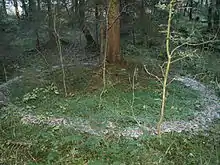Clitocybe nebularis
Clitocybe nebularis or Lepista nebularis, commonly known as the clouded agaric or cloud funnel, is an abundant gilled fungus which appears both in conifer-dominated forests and broad-leaved woodland in Europe and North America. Appearing in Britain from late summer to late autumn, it is edible.[2] It is classified as a category 4 edible mushroom in Russia.[3]
| Clitocybe nebularis | |
|---|---|
_tussen_afgevallen_beukenblad_(d.j.b.)_01.jpg.webp) | |
| Scientific classification | |
| Kingdom: | Fungi |
| Division: | Basidiomycota |
| Class: | Agaricomycetes |
| Order: | Agaricales |
| Family: | Tricholomataceae |
| Genus: | Clitocybe |
| Species: | C. nebularis |
| Binomial name | |
| Clitocybe nebularis | |
| Synonyms[1] | |
|
Agaricus nebularis Batsch (1789) | |
| Clitocybe nebularis | |
|---|---|
float | |
| gills on hymenium | |
| cap is convex or flat | |
| hymenium is decurrent | |
| stipe is bare | |
| spore print is cream | |
| ecology is saprotrophic | |
| edibility: not recommended | |
Taxonomy
The species was first described and named as Agaricus nebularis in 1789 by August Johann Georg Karl Batsch. It was later placed in the genus Clitocybe in 1871 by Paul Kummer as Clitocybe nebularis. After much consideration by many mycologists, over some years, when it was placed for periods in both Lepista, and Gymnopus, it was placed back in Clitocybe with the specific epithet, and 1871 creditation it retains today.
Clitocybe nebularis var. alba Bataille (1911), differs only in having a milk white cap, and is very rare.[2]
Description
The cap of the mushroom is 5–25 cm (2–8 in) in diameter, convex with an incurved margin, becoming plane to depressed in shape. Cap colours are generally greyish to light brownish-grey, and often covered in a whitish bloom when young. The surface of the cap is usually dry to moist, and radially fibrillose. The stem is stout, swollen towards the base, becomes hollow with age, and is easily broken. It is usually somewhat lighter than the cap.[2] The flesh is white, and very thick. It has a foul-smelling odour, which has been described as slightly farinaceous to rancid.[4]
This species is host to the parasitic gilled mushroom Volvariella surrecta, which is found on older specimens.
It may be confused with the poisonous Entoloma sinuatum both in Europe or North America, though this species has pink sinuate gills.[5]
Gallery
 The Pileus or cap
The Pileus or cap Detail of the gills
Detail of the gills The gills and cut stipe (stalk)
The gills and cut stipe (stalk) C. nebularis growing in a fairy ring formation
C. nebularis growing in a fairy ring formation_(d.j.b.)_02.jpg.webp) Close up of the top of a fully Clitocybe nebularis.
Close up of the top of a fully Clitocybe nebularis.
References
- "Clitocybe nebularis (Batsch) P. Kumm. 1871". MycoBank. International Mycological Association. Retrieved 2011-10-26.
- "Archived copy". Archived from the original on 2016-03-04. Retrieved 2011-11-17.CS1 maint: archived copy as title (link)
- "Вячеслав Степанов: Грибы Калужской области - Говорушка дымчатая (Clitocybe nebularis )". mycoweb.narod.ru.
- "California Fungi: Clitocybe nebularis". Retrieved 2008-01-11.
- Haas H (1969). The Young Specialist looks at Fungi. Burke. p. 128. ISBN 0-222-79409-7.
- Encyclopedia of Fungi of Britain and Europe - Michael Jordan
- "Clouded Agaric". Wild Food UK. Retrieved 2020-11-06.
External links
![]() Media related to Clitocybe nebularis at Wikimedia Commons
Media related to Clitocybe nebularis at Wikimedia Commons